Red Spiders (In the House and Outside): Pictures and Identification

Red spiders in the house are typically eight-legged arachnids belonging to the genus Nesticodes. These small, red-bodied creatures are usually found lurking in dark corners, in the crevices of door frames and windows, and under furniture. However, there are also other, less common, species of red spiders that live outdoors. For example, the slender red grass spider, the furry jumping red and black cardinal spider, and the sizable reddish-brown woodlouse spider are all kinds of red spiders.
Most people get a bit jumpy when they spot any type of spider scampering across the floor. However, the sight of a red house spider can be particularly alarming. Usually, red is a warning sign in nature, and you may be concerned that the red spider is venomous. You may also be worried if the red-colored arachnid will bite if you disturb it.
Identifying the type of red spider you find in and around your home is vitally important. After all, you don’t want to confuse a harmless red spider with a dangerous brown recluse spider.
This article is a guide to identifying the most common types of red spiders. Descriptions and pictures of the eight-legged creatures will help you recognize the individual spider species.
Are Red Spiders Venomous?
All red spiders are venomous. However, the good news is that red-colored spiders are rarely harmful to humans. Like all arachnids, red spiders bite their prey to inject venom and kill them. But, typically, the bite from most red spiders isn’t enough to cause too much pain and distress to humans.
Two species of indoor red spiders with venomous bites are the common red house spider and the woodlouse spider. A bite from these reddish-looking spiders may cause some pain and red skin swelling. However, the discomfort should go away after a few hours — unlike the nasty bite from a black widow spider that usually requires medical attention.
Red House Spiders – The Most Common Spiders Found Indoors
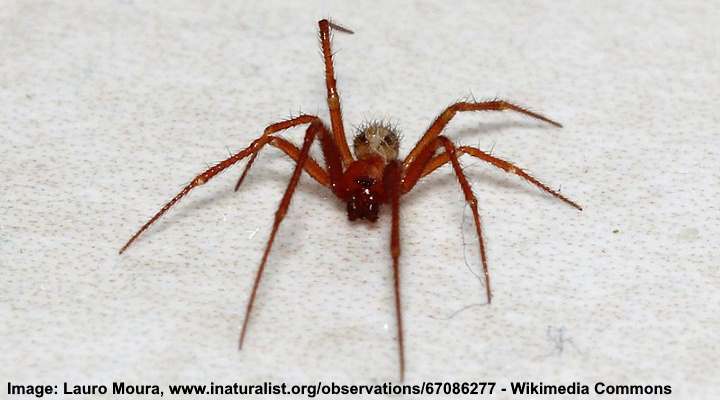
Red House Spider (Nesticodes rufipes)
The most common red spider you’ll likely encounter indoors is the red house spider (Nesticodes rufipes). The small pesky critters like hiding in cool, dark places like in cracks, crevices, and gaps. It’s possible to identify these tiny spiders by their bulbous dark red abdomen and reddish-orange spiny legs.
The red house spider is classified as a comb-footed spider, referring to the comb-like spines on its legs.
These common house spiders also leave tell-tale signs of their activity — messy, tangled webs protecting them from predators. Red house spiders spend about half of their time on their webs and the other half waiting for prey to get trapped.
How to Identify Red House Spiders
The easiest way to identify a red spider in the home is by its shade of red color. Some red spiders are reddish-brown, whereas other spiders have mainly red bodies with black patches or markings. Like all spiders, red spiders have eight legs, six or eight eyes, and chelicerae (mouthparts).
You can also identify red spiders indoors or outdoors by looking for identifiable markings, their body shape, and if the spiders are hairy or smooth-bodied.
Another way of identifying species of red spiders is by the type of web they spin. For example, red house spiders have messy webs, whereas red orb spiders spin beautiful circular webs.
Red Spider Mite (Tetranychus urticae) – Tiny Red Spider
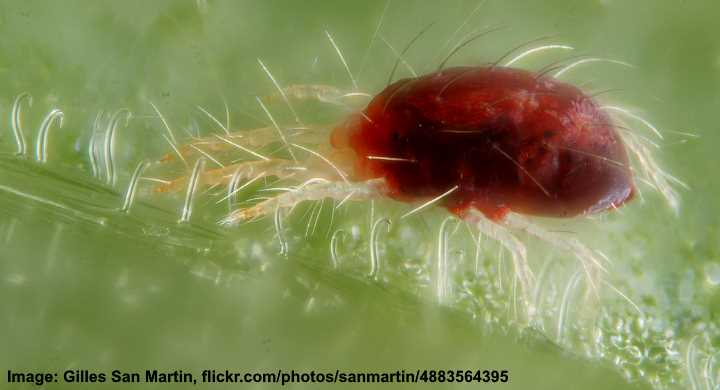
A close up picture of a red spider mite
Red spider mites are tiny destructive pests with a red body and minuscule white legs. Belonging to the spider class Arachnida, the red mite has eight legs and spins webs on plants. The plant-destroying red spider mite bites into soft plant tissue to feed on the juices.

Red spider mites on a leaf underside
Red spider mites on plants can be challenging to recognize. This is because the red bugs only measure 0.016” (0.4 mm) long. Usually, the first sign of red spider mite activity is silky webs or threads dangling from plant foliage. A large infestation of red spider mites will look like tiny red dots on plants.
Related reading: How to get rid of spider mites for good.
Types of Red Spiders (With Pictures) – Identification Guide
Let’s look in more detail at how to identify the types of red spiders you may find in your home or garden.
Red House Spider (Nesticodes rufipes)

A male red house spider
The red house spider is the most common type of red spider you’ll find indoors. The small, red-bodied creature is identified by its dark red, bulbous body and reddish-brown legs. Red house spiders measure 0.2” to 0.33” (5 – 8 mm). The tiny spider looks like a red, black widow spider.

Male (top) and female (bottom) red house spider
One of the signs of a red spider is a tangled, messy web, usually near where these reddish-brown or orangey-brown creatures like to live. Their habitat is typically in dark, cool areas of your home, especially near doors and windows. As a solitary type of arachnid, red spiders tend to live alone.
Red house spiders are also classed as tangle-web spiders, comb-footed spiders, and cobweb spiders.
Red house spiders are not considered harmful to humans. They can bite and leave a painful, swollen mark that lasts a few hours. However, this common red spider has non-necrotic venom — meaning its bite isn’t as serious as a brown recluse or black widow spider.
Bites from red house spiders tend to occur when you disturb their nest or web. However, the spiders are not aggressive and will try to scurry away rather than attack.
Red Spider Identification
A red house spider is identified by its globe-like dark red abdomen and cephalothorax, spiny orange-red legs, and messy, tangled webs.
Red House Spider Facts
Red house spiders are common throughout most temperate regions of the world. The red spiders belong to the Arthropoda class Arachnida and the family Theridiidae. The red house spider is the only member of the genus Nesticodes.
Red house spiders are found in Florida, Texas, and California because they tend to prefer hotter locations. However, you will find them in houses throughout North America as they also inhabit cooler areas inside homes.
Looking at pictures of red house spiders, you may think they look like dark red black widows, or brown widow spiders. This is because red house spiders are in the same family, Theridiidae. However, red house spiders lack the characteristic hourglass markings of black widows.
Although they are venomous creatures, red house spiders aren’t dangerous. A red spider bite can cause some swelling and pain. In some ways, red house spiders can be beneficial animals because they prey on houseflies, ants, and pantry bugs.
Blacktailed Red Sheetweaver Spider (Florinda coccinea)
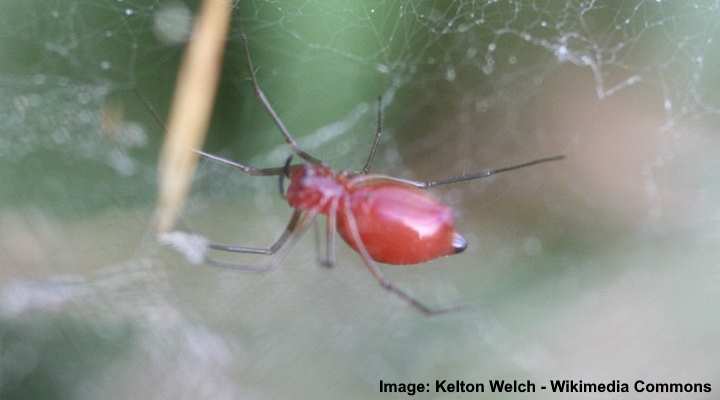
The tiny blacktailed red sheetweaver has reddish body, slender black legs and black tail-end
The blacktailed red sheetweaver is a bright red spider identified by the black mark on its tail end. The small red spider grows 0.12” to 0.16” (3 – 4 mm), but its long spindly legs make it appear larger. As well as having eight legs, the spider has eight eyes.
Also called the red grass spider, this species typically only lives outdoors. So, you may spot the slender red spider in lawns, grasslands, and weeds. The characteristic signs of the red grass spider are a horizontal sheet of sticky webs — hence its common name of sheetweaver spider.
The spider’s abdomen and cephalothorax are bright red. The only black markings on the spider are the area around the eye region and its tail. Its black caudal tubercle (black tail part) is the best way to identify the bright orangey-red spider.
Red Spider Identification
The blacktailed red sheetweaver spider is identified by its bright red body, dark legs, and conspicuous black mark at its tail.
Woodlouse Spider (Dysdera crocata)

The woodlouse spider is dark red-orange and brown spider with an elongated body
The woodlouse spider is a dark red spider with a shiny brownish abdomen. Compared to the red house spider, this red species is larger, measuring 0.43” to 0.6” (11 – 15 mm) long. Its characteristic features are translucent orangey legs, an elongated dark red cephalothorax, and a duller abdominal region.
Woodlouse spiders get their name from their diet of pillbugs or woodlice. Other common names for this dark red spider are slater spider, woodlouse hunter, sowbug hunter, and pillbug hunter.
Red woodlouse spiders tend to inhabit outdoor areas. They prefer lurking under rocks, plant pots, and leaf litter, especially where woodlice live. Woodlouse spiders are nocturnal and rest during the day. Their habit is to hunt at night rather than spin webs to catch their prey.
Like all red spiders, red woodlouse spiders are venomous and can bite. However, their venom isn’t necrotic, and the punctured skin will usually be red, itchy, and painful.
Red Spider Identification
The red woodlouse spider is a slender dark red spider with red or orange legs and a grayish brown to yellow-brown abdomen. Other identifying features are prominent chelicerae and six eyes.
Types of Red-Orange Spiders (With Pictures) – Identification Guide
Many species of spiders have a reddish-orange appearance with distinctive black marks. These red-orange spiders are typically orb-weaver spiders or jumping spiders.
Cardinal Jumper Spider (Phidippus cardinalis)
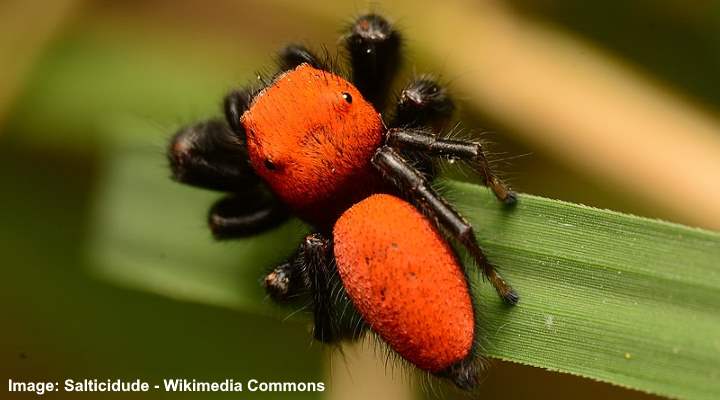
The cardinal jumper spider has red-orange furry body with black hairy legs
The cardinal jumper is a robust orange-red spider with a fuzzy oval abdomen and large cephalothorax. The shape of this red spider resembles a tiny tarantula. The furry spider is identified by a row of eyes with two standing out middle eyes and jet-black hairy legs.
Also classed as an orange spider, the cardinal jumper only measures 0.4” (10 mm) long. A unique habit of the small red-orange and black spider is its ability to mimic wingless mutillid wasps. Due to their size and appearance, they are also called velvet ants.
The spider’s habitat is the eastern United States, where it’s a predatory spider hunting fruit flies, cockroaches, and small crickets. Although the red-orange cardinal jumper spider has powerful chelicerae that inject venom, its bite is harmless to humans.
Red Spider Identification
The cardinal jumping spider has a furry red-orange body with black or grayish-black legs. It also has a row of eyes with two prominent middle eyes.
Whitman’s Jumping Spider (Phidippus whitmani)

Whitman’s jumping spider is a red and black spider with white hairs on its legs
The male Whitman’s jumping spider has a conspicuous red-orange furry cephalothorax and oval abdomen. This brightly colored reddish body contrasts with its gray hairy legs. The velvety red and gray spider measures 0.4” (10 mm) long. Like the related cardinal jumper, the spider has two prominent middle eyes.
Whitman’s jumping spider usually lives outdoors, inhabiting fields and open woodlands. It uses its excellent eyesight to hunt prey rather than spin messy webs to catch bugs, flies, and other insects.
The red Whitman’s jumper spider can also inflict a nasty bite if it feels defensive. However, the spider’s venomous bite isn’t harmful to humans and will cause a few hours of redness and itchiness.
Red Spider Identification
The Whitman’s jumping spider’s noticeable features are its bold red or deep-orange body, four eyes on the front of its head, and hairy gray legs.
Rubens Orbweaver (Hypsosinga rubens)
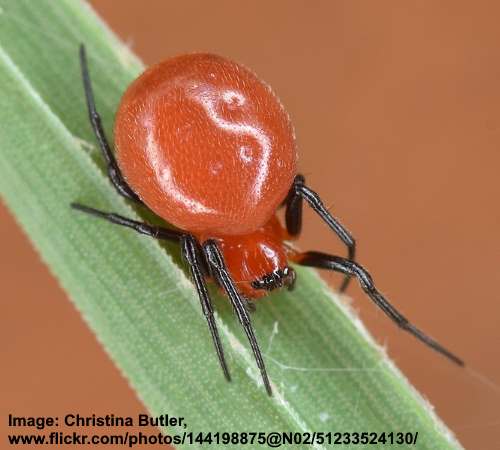
The tiny Rubens orbweaver spider is identified by its round red abdomen and black legs
Rubens orb-weaver is one of the most striking red-orange spiders due to its ball-like swollen abdomen, small head, and shiny jet-black legs. The tiny shiny red spider measures 0.18” (4 mm) long. Its habitat is garden areas where it spins intricate orb webs to catch prey.
The spectacular red Rubens orb-weaver gets its name from the type of web it spins. The webs are circular, made up of non-sticky silk to which the orb-weaver adds stick droplets. The attractive web usually stretches between stems of plants or shrubs where it can trap flies.
Red Spider Identification
The Rubens orb-weaver is identified by its bulbous orange-red abdomen and jet-black legs.
Red Spiny-Backed Orb Spiders (Gasteracantha)
Red spiny-backed orb spiders are some of the most unusual spiders you’ll encounter in a garden. The eye-catching spiders have six conspicuous spines on their oval abdomen. The web-spinning spiders are also called crab spiders because of their distinctive crab-like shape.
There are over 70 species of spiny-backed orb spiders, many of which are white spiders with black dots. However, there are a few types of red spiny-backed spiders.
Red Spiked Orb Weaver Spider (Gasteracantha falcicornis)
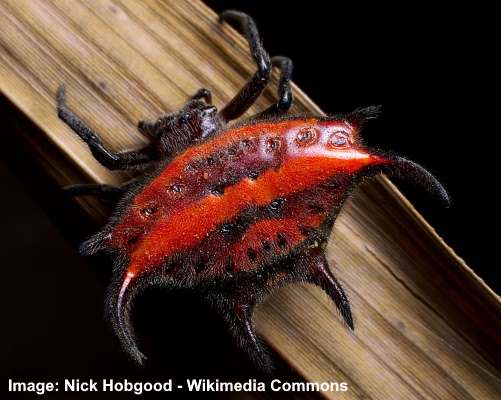
The red spiked orb weaver spider can be easily identified by its unusual body shape
The red spiked orb-weaver is a strange-looking bright red spider with curled black spines on its crab-like abdomen. This oval, slightly fuzzy spider has rows of pitted black spots and two dark reddish-burgundy horizontal stripes on its back. The tiny spider’s head is dark maroon.
Red spiked orb-weaver spiders measure around 0.39” to 0.51” (10 – 13 mm) wide and 0.19” to 0.35” (5 – 9 mm) long. The spiny red spider is often seen in the middle of spectacular orb webs waiting for its prey. In addition, you’ll find this weird red spider in shrubby gardens and woodlands.
Red Spider Identification
The Red spiked orb weaver spider is easily recognizable by its deep red body six with long curved horn-like spines emerging from its abdomen.
Red Thorn Spider (Gasteracantha versicolor formosa)
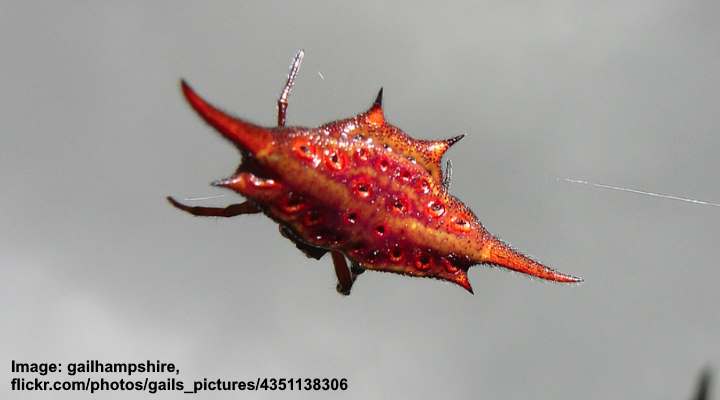
The unique looking red thorn spider has a red and orange body with two large horns on its sides
The red thorn spider is a brightly colored, odd-looking red orb-weaver spider with orange stripes and dimpled spots on its back. The identifying features of the red thorn spider are two long curved horns protruding from its sides with two smaller spiky spines at its front and rear.
The red thorn spider also goes by the name long-winged kite spider. The tropical shiny red spider has the appearance of a kite from head-on. The hardened red abdomen projects over the cephalothorax. As with most spider species, the female is the largest and most colorful.
The red thorn spiny orb-weaver spider measures 0.31” to 0.39” (8 to 10 mm) at its widest part (excluding the two long thorny projections).
Red Spider Identification
The identification features of the red thorn spider are its brightly-colored red abdomen, six peripheral spines, and reddish-brown legs.
Related articles:
